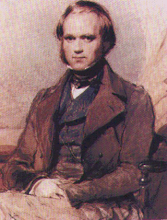
Darwin’s “warm little pond” scenario for the origin of life on earth may not have been hot enough to do the work of chemosynthesis, combining the elements of life—CO2, methane, and water—into more complex biological compounds.
Some researchers suggest that hydrothermal vents like those found today in abyssal ocean depths are a more likely candidate for the environment in which life first evolved.
Water gushing from hydrothermal events tends to be alkaline from reaction with minerals in the earth’s crust. When an alkaline hydrothermal fluid (that is, a fluid with low Hydrogen ion levels) mixes with acidic seawater (which has a higher H ion concentration), the resulting pH gradient creates potential energy that can be used to power chemical reactions by the diffusion of hydrogen ions in a process called chemiosmosis. The oldest and simplest forms of life on Earth may have used chemiosomosis as an energy source.
Source: Nicole Branan writing in Earth, May 2010, based on research by Wm Martin and others in BioEssays
Photo credit: http://www.astrobio.net/exclusive/5/reflections-from-a-warm-little-pond











